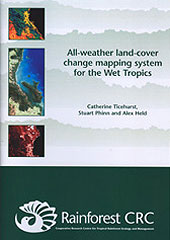 |
||||
 |
Back to Research Report Series |
|||
| Report
No. 23 All-weather Land-cover Change Mapping System for the Wet Tropics Research Report Catherine Ticehurst, Stuart Phinn and Alex Held ISBN 0 86443 692 0 |
||||
|
This publication outlines a methodology using satellite images collected by a radar system for mapping land-cover changes in tropical environments. Radar sensors are 'active' imaging systems, providing their own source of illumination, and thus can be reliably used in (cloud and smoke prone) tropical environments. For vegetation, radar systems provide information relating to structure, such as height and density of trees. The study demonstrates
the utility of imaging radar data (from the Japanese JERS satellite)
as a surrogate for, and add-on to Landsat and aerial photographic imagery
in particular for change detection analysis in the rainforests of the
Wet Tropics Bioregion of far north Queensland. |
 |
|||
|
|
||||
| Back to top | ||||
 |
||||